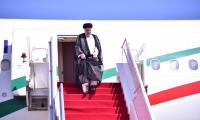On March 23, the last piece of land held by the Islamic State, also known as Daesh, fell to the US-backed Kurdish forces. That event sounded the death-knell for the ‘caliphate’ founded in June 2014 by Abu Bakr al-Baghdadi, which stretched over 34,000 square miles and controlled a population of 10 million. The fall of Daesh has been as dramatic as its rise.
If Al-Qaeda was the most dreaded transnational cataclysmic organization of the last decade, the IS earned that dubious distinction in recent years. The IS accomplished what Al-Qaeda could not – it took possession of large tracts of land, comprising Sunni provinces in Iraq and eastern regions in Syria. Many believe Al-Qaeda didn’t carve out a territory by design, which would have made it an easier target. Ideology, rather than territorial sovereignty, has been the mainspring of its strength.
The economics and demographics of the Middle East together account for the growth of brands like Al-Qaeda and Daesh. The two major drivers of the rise of Daesh were foreign intervention in the Middle East and the sectarian schism. Because of its strategic importance and tremendous oil wealth, the Middle East has been a flashpoint of international politics.
In the post cold-war era, Washington and its Western allies, duly supported by the Gulf States and at times by Turkey, have intervened in different countries for regime change. In both Iraq and Libya, the intervention was successful; while in case of Syria, the interveners failed to hit the bull’s eye. Whether successful or abortive, the efforts for regime change destabilized these countries providing a fertile ground for the IS leviathan to raise its head.
The Middle East is a Sunni majority region where a substantial Shia population also resides. In countries such as Iran, Bahrain and Iraq, Shias have been in majority. However, until the ouster of Saddam Hussein in 2003, Iran was the only Shia majority country in the region where the government was in the control of the adherents of that sect. Syria stands out as a special case where Shias despite being in minority have been at the helm since 1970.
Iran and Saudi Arabia, representing Shias and Sunnis respectively, have competed to control the region. Alarmed by the 1979 Islamic Revolution in Iran, the Gulf States intensified propagation of their own brand of Islam and cashed in on their petro-dollars rather lavishly for that purpose. They also joined hands with the US in encircling Iran.
The advent of the Arab Spring in 2010 set up a new challenge for the established orders in Arab countries. A civil war broke out in Syria, which exacerbated Iran-Saudi or Shia-Sunni tensions, with Tehran and Riyadh going all out to support and bring down respectively the Assad regime. Not to be left behind, Hezbollah fought on the side of the Syrian government, while Al-Qaeda and its affiliated organizations became part of the anti-Assad coalition. The Syrian civil war became a hot spot for Muslim militants all over the world.
To exploit the growing instability in the region, the remnants of Al-Qaeda in Iraq set up the Islamic State of Iraq and Syria (Isis), which took possession of large tracts of land comprising Sunni provinces in Iraq and eastern regions in Syria. In June 2014, it was renamed the Islamic State (IS) and its leader Abu Bakr al-Baghdadi proclaimed himself khalifah (caliph), which by definition is a transnational office to which Muslims all over the world owe allegiance.
The IS brought about what the Taliban did in Afghanistan in the late 1990s: established law and order in the territory it held, enforced a strict brand of Islamic law and unleashed a reign of terror. Tens of thousands of supporters of Daesh set down its quick victories to divine providence. Here was an army of the ‘faithful,’ which was set on putting to sword both non-believers and sinners. Daesh also made adroit use of social media. That is the reason the organization became so attractive for Muslim youth from different parts of the world, who saw in it either an answer to their search for identity or a way out of their disillusionment with their governments. At the same time, the chaos unleashed by the rise of Daesh precipitated a mass exodus into Europe and other developed nations and in reaction helped Far-Right forces ride a crest of popularity.
Paradoxically, all the powers that have stakes in the Middle East had cause for raging against the IS, if for nothing else but its diabolical credentials, but many of them thought they might lose in the event that the organization’s teeth were drawn. It is those apprehensions that account for Daesh’s initial success.
The US and its European allies felt that emaciation of the IS would bolster the Assad regime, which they had set themselves upon to topple. Faced with the choice to bomb Daesh sanctuaries or Syrian government installations, Washington and its allies under Barack Obama – yes the same Obama who would pose himself as a champion of peace and liberalism – went after the latter. The US put its money on the Syrian Democratic Forces (SDF), which were mainly drawn from the Kurds, in its efforts to topple Assad.
Turkey felt threatened not as much by Daesh as by the Kurds, who, thanks to instability in Iraq and Syria, carved out a territory of their own. Turkish forces bombed the Kurds to the advantage of Daesh. Ankara was also instrumental in the creation of the Syrian Free Army to have its own sphere of influence in Syria.
The Kurds, for their part, were interested not in the end of the IS but in defending the land they held. Besides, for them a strong central government in Baghdad or Damascus was anathema. In the presence of the IS, such a government was difficult to set up.
Then there were the Gulf States with Riyadh at their head. The IS’s two over-ridding characteristics made the movement at once a friend and a foe of the Gulf monarchies. It championed the cause of a puritanical sub-sect of Sunni Islam, which brought it doctrinally closer to Saudi Arabia and its Middle Eastern allies. They also feared that in case the Western powers targeted Daesh with their full might, it would give breathing space to the Assad regime and thus benefit Iran. At the other end of the scale, the IS wanted to overthrow the reigning absolute monarchies in the Gulf and put in place an all-encompassing caliphate through the instrument of what it called jihad.
The Assad government has also been accused of buying oil from the IS. While such allegations may be devoid of substance, it can’t be denied that in view of the existential threats that it faced the regime’s priority was to fend for itself rather than smash up the IS.
The reversal of fortune for the IS began in 2016. The following year it suffered howling defeats one after the other. It was driven out of Mosul, Iraq’s second largest and oil rich city, and the Syrian city of Raqqa, which also served as the caliphate’s de facto capital, by the Iraqi army and the Washington-backed SDF, while the Syrian troops reclaimed control at the Euphrates. Thenceforth, it was only a matter of time that the organization would be beaten.
That said, it’s premature to say that the Daesh threat is over. For one thing, the factors which contributed to the rise of the organization – the sectarian schism, regional rivalry, political instability, and international petro politics – are very much alive. For another, the radicalism espoused by the IS still holds traction for the disillusioned and ‘rootless’ youth. The leviathan may not be dead; it may only have gone into hibernation.
The writer is an Islamabad-based columnist.
Email: hussainhzaidi@gmail.com
Twitter: @hussainhzaidi
An aeroplane of the national flag carrier of Pakistan is seen in this file photo. — AFPWhile Pakistan considers...
Representational image of a graph depicting various variables. — APP/FileInitiated by the centre and fiercely...
In this picture taken on April 16, 2023, people throng a market area during shopping in Lahore. — AFPOne of the...
Honour crimes also target men. In Sikandar Ali Lashari vs The State, SHC upheld conviction passed by ATC for honour...
If Sindh earmarks Rs20 million per police station, it will cost only Rs10 billion to make them effective first...
A complex and difficult policy environment seems to be highlighted by US’s recent application of sanctions on...







